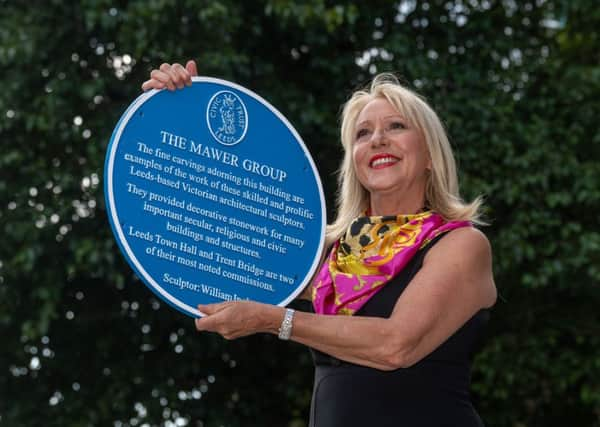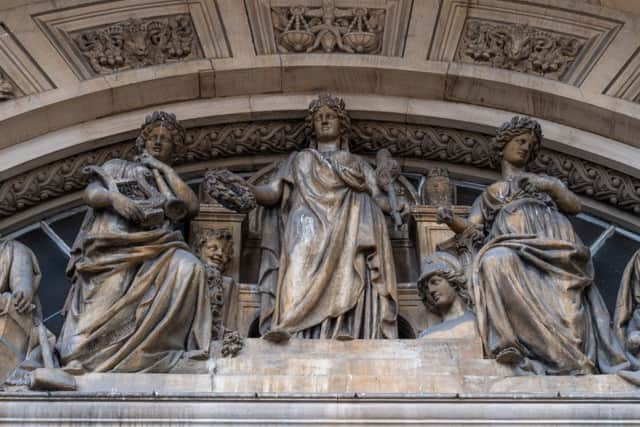Home Leeds honour for pioneering Victorian sculptor is unveiled


Yet the forgotten sculptor was a pioneer in her field, blazing a trail for women in artistry a century before the internationally-acclaimed Dame Barbara Hepworth emerged onto the scene.
With an eye for intricacy, Mawer crafted decorative stonework for buildings across Yorkshire, her most famous work perhaps being the Corinthian capitals and ornamental roof turrets that still adorn Leeds Town Hall today.


Advertisement
Hide AdAdvertisement
Hide AdBut not only was she a celebrated sculptor in her own right, she was also an astute businesswoman, successfully running a family stoneyard in Great George Street in central Leeds for several decades following the death of husband Robert, at a time when many women were tied to domestic duties.
It is for these reasons that a blue plaque was unveiled in recognition of Mawer in the city of Leeds this week, alongside a second for the Mawer Group of sculptors, of which she was a member.
The collective, made up of members of the Mawer and Ingle families, who were related by marriage, worked together throughout the Victorian era decorating many buildings and structures in the region and beyond, with Trent Bridge in Nottingham amongst their high profile work.
Martin Hamilton, director of Leeds Civic Trust, said the plaques recognise the contribution of Mawer and her colleagues to the architectural landscape during the 1800s, claiming that their detailed design work was often overlooked and architects or owners were typically given credit for buildings as a whole.
Advertisement
Hide AdAdvertisement
Hide AdHe said: “We admire the grandeur of our Victorian buildings but forget to consider the detail that makes them so special. These plaques recognise the work of a group of highly-skilled sculptors who dominated this industry in the 19th century in Leeds but who are largely unknown to the general public.
“They were called upon particularly for important, impressive, statement buildings,” he added.
Mawer was suggested to the civic trust as a plaque recipient by local historian Linda O’Carroll, who has researched the family and examples of their work that remain in existence. The trust wanted to recognise more women who played an important role in the development of Leeds and scheduled the unveiling, at the Henry Moore Institute, to tie in with the ongoing Yorkshire Sculpture International festival, which is celebrating the region’s strong reputation for the art.
But while the area is famed in particular for the work of Wakefield-born Hepworth and Castleford’s Henry Moore in the 20th century, Mr Hamilton said Mawer and her colleagues were evidence of a sculpting history that goes back at least 100 years prior to them – and one which remains significant today. He said: “Barbara Hepworth and Henry Moore are big names and people may have an image of the sort of work that they did, or may have seen it.
Advertisement
Hide AdAdvertisement
Hide Ad“But if you think about impact, what could be more impactful than coming on the bus to Leeds, driving past the town hall and seeing the wonderful sculpture?
“That has a huge impact on people every day of the year.”
The plaques, unveiled by artists Jill McKnight and Pippa Hale, will ultimately be placed on prominent buildings associated with the sculptors in Albion Street and Park Place.
GROUP’S NOTED COMISSIONS
The Mawer Group was a skilled and prolific collective of architectural sculptors based in Leeds who provided decorative stonework for many important secular, religious and civic buildings and structures. Among their most noted commissions were Leeds Town Hall and Trent Bridge.
Catherine Mawer was responsible for the Corinthian capitals and ornamental roof turrets on the town hall and decorations for many Yorkshire churches. Although unattributed at the time, there is speculation that lifelike sculptures, depicting men with large moustaches and open mouths, that feature on numerous Leeds buildings are her doing, as the signature style ceased after she died.